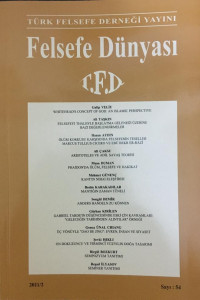Abstract
Kant felsefesini üç temel eleştiri üzerine inşa edilmiştir. İlk eleştiri teorik
aklın doğa üzerine bilgimizi ikinci eleştiri ise pratik aklın ahlak üzerine bilgimizi
açıklamıştır. Buna karşın inşa edilen bu iki akıl arasında bir uçurum oluşmuştur.
Son eleştiri bu uçurumun kapanmasını amaçlamıştır. Bunu yaparken
Kant güzel ve yüce gibi farklı kavramlar ve beğeni yetisinde yer alan reflektif
yargıya başvurmuştur. Yazımızda doğa ile ahlak arasındaki uçurumun kapatılıp
kapatılmadığını inceledik. Bunun yanında ortaya çıkan sonucun Kant’ın bütün
felsefi sisteminde bir farklılık anlamına gelip gelmediği tartışılmıştır.
Keywords
References
- Immanuel Kant, Yargı Yetisinin Eleştirisi, çev. Aziz Yardımlı, İdea Yayınevi, 2006.
- Immanuel Kant, Critique of Pure Reason, tr. By Norman Kemp Smith, St. Martin’s Press, 1965.
- Immanuel Kant, Pratik Aklın Eleştirisi, çev. Ioanna Kuçuradi,Ülker Gökberk, Füsun Akatlı, Hacettepe Yayınları, 1980.
- Kai Hammermeister, German Aesthetic Tradition, Cambridge University Press, New York, 2002. http://site.ebrary
- Christian Helmut Wenzel, An Introduction To Kant’s Aesthetics, Blackwell Publishing, 2005.
- Ernst Cassirer, Kant’ın Yaşamı ve Öğretisi, İnkilap Kitabevi, 1996.
- Paul Guyer, “Feeling and Freedom: Kant on Aesthetics and Morality”, The Journal of Aesthetics and Art Criticism Vol no:2 Spring 1990.
- Christian Helmut Wenzel, An Introduction To Kant’s Aesthetics, Blacwell Publishing, 2005.
- Andrew Ward, Kant and Three Critiques, Polity Press, 2006.
- Rudolf A. Makkre, Imagination and lnterpretation in Kant, The University of Chicago Press,1990.
- James Kirwan, Aesthetic in Kant, Continuum, 2004.
- A Companion to Kant, ed. By Graham Bird, Blackwell Publishing, Blackwell Publishing, 2006.
- Patricia M. Matthews, “A Form of Pure Aesthetic Reflective Judgement”, The Journal of Aesthetics and Art Criticism, Vol. 54, No.2(Spring 1996),p.174, Blackwell Publishing, http://www.jstor.org. pp. 165-180.
- Paul Guyer, “Beauty, Freedom and Morality, Kant’s Lectures on Anthropology and the Development of His Aesthetic Theory.” Essays on Kant’s Anthropology, ed. by Brian JAcobs, Patrick Kain, Cambridge University Press, 2003.
- Brent Kalar, Demands of Taste in Kant. London, GBR: Continuum International Publishing, 2006.
- Cemil Sena, Estetik, Remzi Kitabevi, 1972.
- Taylan Altuğ, Kant Estetiği, Payel Yayınları, 1989.
Abstract
Kant based his philosophy upon three critiques. While the first one of
these critiques explained the knowledge of reason about nature, the second one
explained the knowledge about morality. However, there emerged a space room
between these two reasons. The last critique aimed to fill this space. In order to
do this, Kant applied to use some concepts such as beautiful and sublime and reflective
judgement which is given under the faculty of desire. In this article, I’ve
examined whether this space were filled or not. In addition to this I’ve discussed
the results if they mean any difference in his whole philosophical system.
References
- Immanuel Kant, Yargı Yetisinin Eleştirisi, çev. Aziz Yardımlı, İdea Yayınevi, 2006.
- Immanuel Kant, Critique of Pure Reason, tr. By Norman Kemp Smith, St. Martin’s Press, 1965.
- Immanuel Kant, Pratik Aklın Eleştirisi, çev. Ioanna Kuçuradi,Ülker Gökberk, Füsun Akatlı, Hacettepe Yayınları, 1980.
- Kai Hammermeister, German Aesthetic Tradition, Cambridge University Press, New York, 2002. http://site.ebrary
- Christian Helmut Wenzel, An Introduction To Kant’s Aesthetics, Blackwell Publishing, 2005.
- Ernst Cassirer, Kant’ın Yaşamı ve Öğretisi, İnkilap Kitabevi, 1996.
- Paul Guyer, “Feeling and Freedom: Kant on Aesthetics and Morality”, The Journal of Aesthetics and Art Criticism Vol no:2 Spring 1990.
- Christian Helmut Wenzel, An Introduction To Kant’s Aesthetics, Blacwell Publishing, 2005.
- Andrew Ward, Kant and Three Critiques, Polity Press, 2006.
- Rudolf A. Makkre, Imagination and lnterpretation in Kant, The University of Chicago Press,1990.
- James Kirwan, Aesthetic in Kant, Continuum, 2004.
- A Companion to Kant, ed. By Graham Bird, Blackwell Publishing, Blackwell Publishing, 2006.
- Patricia M. Matthews, “A Form of Pure Aesthetic Reflective Judgement”, The Journal of Aesthetics and Art Criticism, Vol. 54, No.2(Spring 1996),p.174, Blackwell Publishing, http://www.jstor.org. pp. 165-180.
- Paul Guyer, “Beauty, Freedom and Morality, Kant’s Lectures on Anthropology and the Development of His Aesthetic Theory.” Essays on Kant’s Anthropology, ed. by Brian JAcobs, Patrick Kain, Cambridge University Press, 2003.
- Brent Kalar, Demands of Taste in Kant. London, GBR: Continuum International Publishing, 2006.
- Cemil Sena, Estetik, Remzi Kitabevi, 1972.
- Taylan Altuğ, Kant Estetiği, Payel Yayınları, 1989.
Details
| Primary Language | Turkish |
|---|---|
| Subjects | Philosophy |
| Journal Section | Research Articles |
| Authors | |
| Publication Date | December 15, 2011 |
| Submission Date | September 16, 2011 |
| Published in Issue | Year 2011 Issue: 54 |
Philosophy World is licensed under a Creative Commons Attribution-NonCommercial 4.0 International License.


